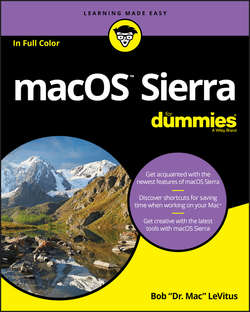Читать книгу macOS Sierra For Dummies - Bob LeVitus - Страница 13
На сайте Литреса книга снята с продажи.
Part 1
Introducing macOS Sierra: The Basics
Chapter 2
Desktop and Windows and Menus (Oh My!)
Menu Basics
ОглавлениеMac menus are often referred to as pull-down menus. To check out the macOS menus, click the Finder button on the Dock to activate the Finder and then look at the top of your screen. From left to right, you see the Apple menu (), the Finder menu, and six other menus. To use an macOS menu, click its name to make the menu appear and then pull (drag) down to select a menu item. Piece of cake!
Note that menus stay down after you click their names, and stay open until you either select an item or click outside the menu’s boundaries.
The ever-changing menu bar
Before you start working with macOS menus, you really, really should know this: Menu items can change unexpectedly. Why? Well, the menus you see on the menu bar at the top of the screen always reflect the program that’s active at the time. When you switch from the Finder to a particular program – or from one program to another – the menus change immediately to match whatever program you switched to.
Figure 2-8 shows the menu bars for the Finder, Preview, and TextEdit applications.
FIGURE 2-8: Menu bars change to reflect the active application.
An easy way to tell which program is active is to look at the application menu – it’s the leftmost menu with a name, just to the right of the menu. When you’re in the Finder, of course, the application menu reads Finder. But if you switch to another program (by clicking its icon on the Dock or by clicking any window associated with the program) or launch a new program, that menu changes to the name of the active program.
When you have an application open, the commands on the menu change, too – but just a little bit. What makes this cool is that you have access to some standard application menu items whether you’re running Mail or Safari. For example, most (but not all) applications have Cut, Copy, and Paste commands in their Edit menus, and Open, Save, and Print commands in their File menus. You can find much more about commands for applications in Part 3, which explains how applications that come with macOS Sierra can help you get things done.
Contextual menus: They’re sooo contextual!
Contextual menus (also called shortcut menus) list commands that apply only to the item that is currently selected. Contextual menus might be available in windows, on icons, and in most places on the Desktop.
To see whether a contextual menu is available, either hold down the Control key and click – which you can call a Control-click to sound cool to your Mac friends – or, for those with two or more buttons on their mice, right-click. Finally, most Mac laptops (as well as the Magic Trackpad and the Magic Mouse) let you click the trackpad using two fingers to simulate a right-click or Control-click.
If this doesn’t work for you, launch System Preferences and click the Trackpad icon. Click the Point & Click tab and make sure that Click with Two Fingers is selected and also that the Secondary Click check box is enabled.
Another reason the contextual menu might not appear is that they are available only if any of their commands make sense for the item that you Control-click or right-click. That’s why people call ’em contextual! They’re specific to the current context, which is whatever is selected or Control-clicked.
Figure 2-9, left, shows the contextual menu that appears when you Control-click (or right-click) a document icon. Figure 2-9, right, shows the contextual menu you see when you Control-click the Desktop.
FIGURE 2-9: Only relevant items appear in a contextual menu.
Contextual menus are also available in most applications. Open your favorite app and try Control-clicking to find out whether those menus are there. In most cases, using a contextual menu is a quick way to avoid going to the menu bar to choose a command. In some programs – such as iMovie, iTunes, and many more – contextual menus are the only way to access some commands.
To make the Finder-related contextual menus available to users who didn’t have the foresight to purchase this book, Apple added the Actions button to the toolbar. As a result, people who don’t know about Control-clicking or right-clicking (or have only one free hand) can access most contextual menu commands by clicking the Actions button and displaying its context-sensitive menu of shortcuts. You, on the other hand, gentle reader, know how to get at these commands without having to run your mouse all the way up to the Action button in the toolbar. Plus, a handful of commands appear in the Control-click/right-click contextual menu but don’t appear in the Actions button/menu.
Конец ознакомительного фрагмента. Купить книгу
